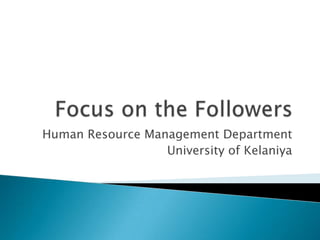
Led session4 presentation
- 1. Focus on the Followers Human Resource Management Department University of Kelaniya
- 2. Leadership behavior makes satisfied followers. Satisfied followers makes organizational citizenship behavior. Accomplishment of common goal. Relationship between Leadership, Motivation, Job satisfaction and Performance
- 4. As against this, McFarland has defined it as follows:
- 5. “ Motivation refers to the way urges, drives, desires, aspirations, strivings, needs direct, control or explain the behavior of human beings.” Definitions of Motivation
- 6. The psychological Process of Motivation An unsatisfied need creates tension that stimulates drives with in individuals. These drives generate a search behavior to find particular goals that , if attained, will satisfy the need and lead to the reduction of tension. Motivation Process
- 7. Need Theories Cognitive Theories Individual Difference Situational Theories Motivational Approaches
- 8. Major theme is to Satisfy needs to change behavior. Maslow’s hierarchy of needs Alderfer’s ERG theory Need Theories
- 9. The hierarchy of needs Theory
- 10. Unsatisfied need drives towards the behavior Satisfied need is no longer working as a motivational factor Lower level needs should be fulfilled to raise the higher level needs Principles of needs theory
- 11. Existence Needs Relatedness Needs Growth Needs ERG Theory ( By Clayton Alderfer)
- 12. Characteristics of Goals Goals should be specific Goals should be attainable but challenging Goals require commitment Goals require feedback Goal setting Theory ( Locke & Latham)
- 13. Goal-Setting Theory (Edwin Locke) Goal-Setting Theory The theory that specific and difficult goals, with feedback, lead to higher performance. Factors influencing the goals–performance relationship: Goal commitment, adequate self-efficacy, task characteristics, and national culture. Self-EfficacyThe individual’s belief that he or she is capable of performing a task.
- 14. . Equity Theory Equity Theory Individuals compare their job inputs and outcomes with those of others and then respond to eliminate any inequities. Referent Comparisons: Self-inside Self-outside Other-inside Other-outside
- 16. Expectancy Theory Expectancy Theory (Victor Vroom) The strength of a tendency to act in a certain way depends on the strength of an expectation that the act will be followed by a given outcome and on the attractiveness of that outcome to the individual.
- 17. 6–15 Expectancy Theory Relationships Effort–Performance Relationship The probability that exerting a given amount of effort will lead to performance. Performance–Reward Relationship The belief that performing at a particular level will lead to the attainment of a desired outcome. Rewards–Personal Goals Relationship The degree to which organizational rewards satisfy an individual’s goals or needs and the attractiveness of potential rewards for the individual.
- 18. Achievement Orientation Values Intrinsic Motivation Individual differences in Motivation
- 19. nPow nAch nAff Three Needs theory ( David McClelland)Need for achievementNeed for powerNeed for affiliation
- 20. Operant Approach Rewards Punishment Extinction Situational Approach
- 21. Implementation of an Operant system Leadership practitioners need to clearly specify what behaviors are important. Leadership practitioners need to determine if those behaviors are currently being punished, rewarded or ignored. Leadership practitioners need to find out what followers actually find rewarding and punishing. Leadership practitioners need to be wary of creating perceptions of inequity when administering individually tailored rewards. Leadership practitioners should not limit themselves to administering organizationally sanctioned rewards and punishments.
- 22. Empowerment having two key components. For leaders to truly empower employees, they must delegate leadership and decision making down to the lowest level possible. Secondly equipping followers with resources, knowledge and skills necessary to make good decisions. Empowerment
- 24. Why do People Leave Organizations Limited recognition and praise Compensation Limited Authority Personal Conflicts Understanding and Influencing followers satisfaction
- 25. Why Do People stay with Organizations Promises of long-term employment Supports training and education Hires/keeps hard-working, smart people Encourages fun, collegial relationships
- 26. Two factor Theory Organizational Justice Theories of job Satisfaction
- 27. Hygiene factors Motivational Factors Present mid point Present Satisfaction Dissatisfaction Two factor theory ( Motivation – hygiene theory)
- 29. Overall, I am satisfied with my job. I feel the workload is about equal for everyone in the organization. My supervisor handles conflicts well. My pay and benefits are comparable to those in other organizations. There is a real future for people in this organization. Exceptional performance is rewarded in this organization. We have a good health care plan in this organization. In general, I am Satisfied with my life and where it is going. Typical Items on a satisfaction Questionnaire
- 30. Organizational Justice Distributive Justice Perceived fairness of the amount and allocation of rewards among individuals. Procedural Justice The perceived fairness of the process to determine the distribution of rewards.
- 31. Performance is a broader concept than motivation, as abilities, skills, group norms and the availability of resources can all affect followers’ levels of performance. Job satisfaction is a set of attitudes that peoples have about work. In motivational theories Maslow’s hierachy of neds and Alderfer’s existence-relatdeness-growth (ERG) theory assume that people are motivated to satisfy a universal set of needs. Summary
- 32. The other next theories examined motivation in terms of individual differences, emphasizing a person’s intrinsic motivation to perform a particular task, their personal values or a person’s general level of achievement orientation. Other theories of Goal setting , equity theory, self efficacy and expectancy theory examined motivation from a cognitive perspective.
- 33. Empowerment, operant approach examined motivation from a situational perspective. Leadership practitioners likely will be more effective if they learn to recognize situation where various approaches or the insights particular to them, may be differently useful. Leaders may also increases the satisfaction levels by giving followers more meaningful work and by treating them fairly.
- 34. Followers are more likely to have positive attitudes about work if they believe that what they do is important and that the reward and disciplinary systems are fair and just.
